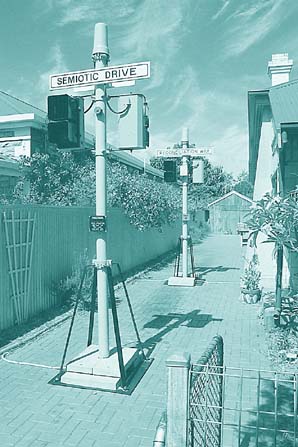Outside the Cube
Jena Woodburn

Gavin Malone, Driveway
photo Philip Hind
Gavin Malone, Driveway
Originally conceived of as an annex to the more ‘legitimate’ Adelaide Festival, the Fringe has this year seemingly surpassed it in both popularity and visibility. While the Adelaide Festival had attracted controversy since it announced that there would be no specific visual arts program, the Fringe’s visual arts content was, as usual, plentiful, dynamic and varied. Though its all-welcome policy can result in a notoriously hit-and-miss program, in which the works are as diverse in standard as in content, the anything-goes atmosphere aroused a sort of undiscriminating enjoyment in which critical analysis became almost redundant.
Fringe exhibitions were hosted in unorthodox locations: hotels, cafes and pubs, public spaces, shop windows, attached to the bars of carparks, the gardens and driveways of people’s homes. Oscar Ferreiro’s Skidmarks was based in various suburban service stations, where viewers directed by a list on the internet could examine patterns of tyre marks left by speeding cars. The Driveway project involved private driveways and backyards displaying works viewed on a walking tour. Held over 3 weekends, viewers visited houses around Adelaide, watching artists cutting the lawn with scissors or transforming garden sheds with lightboxes and webs of plastic.
In its own version of the lonely hearts database, Fringe organisers connected prospective exhibitors with venues—the ensuing assignations ranged from successful to dubious. Hindley Street and its surrounds were the focus in the city, which is demonstrative of the success of recent pressure to re-create the formerly seedy west end as the “Arts End.” Not for white cube devotees, exhibitions were held in hotels, shops and clubs, in the cinema and in shabby, disused buildings. Results were mixed: a venue such as the Novotel was eminently suitable for the classy Passion Pop, a collection of ceramics and glass, as well as the beautiful Anangu Pitjantjatjara silks that floated in its foyer. In contrast, the many cafe and club settings, as they often do, tended to undermine the artistic merit of displayed works, relegating them to decoration.
The Fringe’s ability—and willingness—to incorporate a variety of work saw it encompass such diverse showings as the Helpmann Academy exhibition of art school graduates, and From The Inside, a collection of works by Aboriginal people in jail. Exhibitions such as the rigorously theoretical, concept-driven photographs of Polyopia’s Mise au Point contrasted with the emphasis on technique and naturalistic aesthetic of the many craft-oriented shows. All the exhibitions reinforced this sense of diversity, as the viewer indulged in an almost gluttonous consumption.
Adelaide Fringe, Visual Arts Program, various locations, Feb 5 – March 17
RealTime issue #48 April-May 2002 pg. 8






